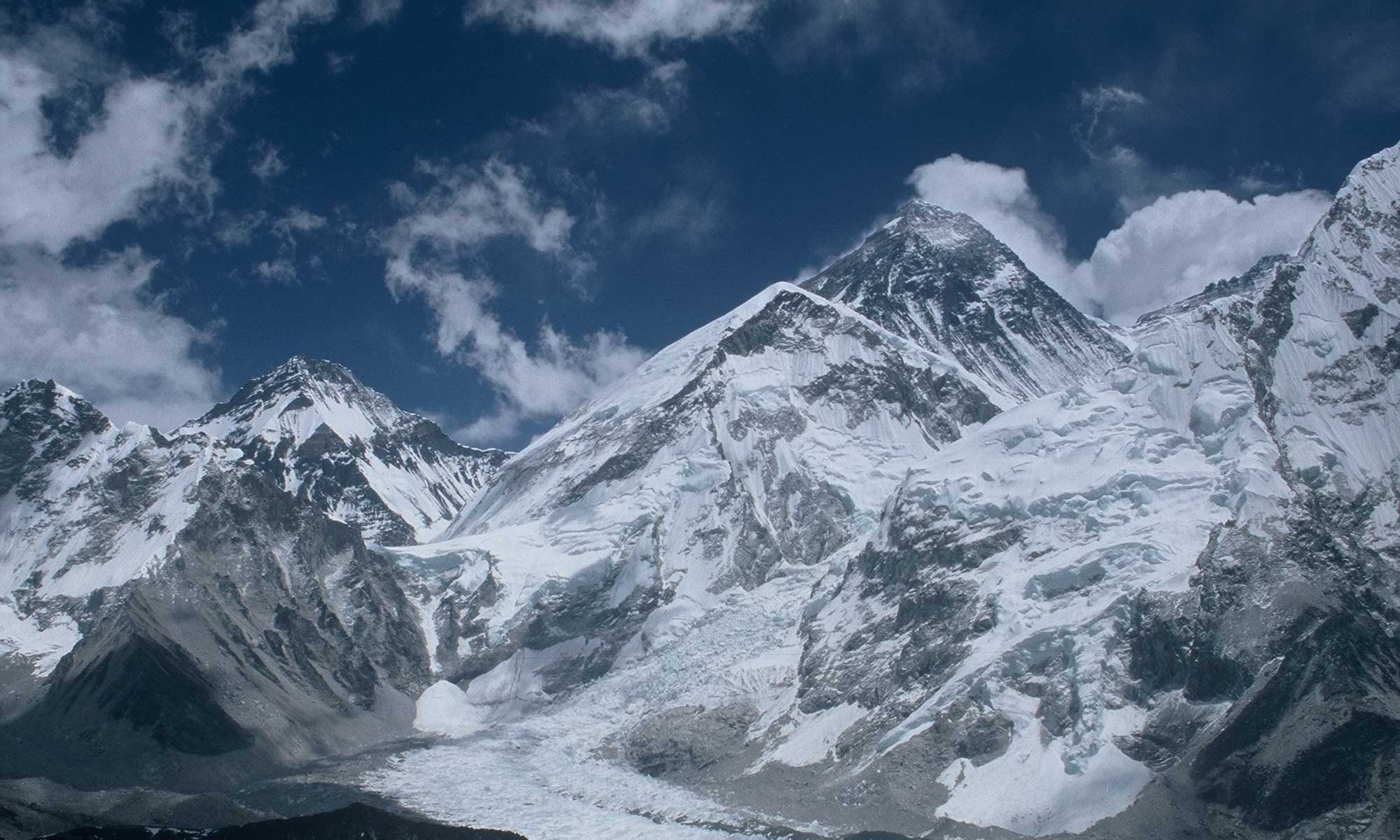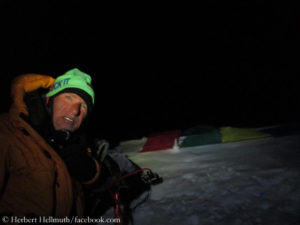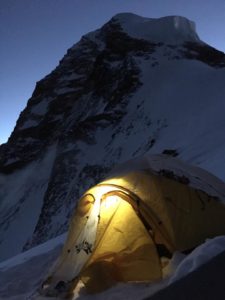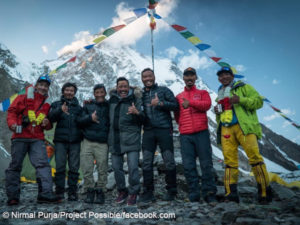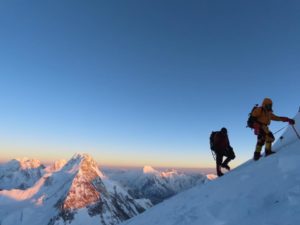“I have never been so scared as I was on this mountain”, says Herbert Hellmuth about K2 in the Karakoram in Pakistan. On 25 July, at three o’clock in the morning, still in the dark, he stood on the 8611-meter-high summit of the second highest mountain on earth – and wanted to descend again as quickly as possible: “At the summit a really strong wind blew, and it was accordingly cold: without wind chill between minus 30, minus 35 degrees. When the wind whistles, you are quickly at minus 40, minus 50 degrees. Then, if the camera isn’t frozen, you take two quick pictures and make sure you get away as soon as possible.”
Especially the so-called “Bottleneck”, a narrow couloir at about 8,000 meters under a hanging glacier, made him afraid, Herbert tells me: “You’re standing under this serac and see chunks of ice as big as cars in front of you. And you know very well that they fell down recently.” He managed to “put his fear aside”, says the 50-year-old. He simply had no alternative. “I thought to myself: the others also ran up there yesterday. Nothing will happen.”
Tied to apron strings
Still, the queasy feeling remained. In 2018, Herbert had met Marco Confortola at the eight-thousander Kangchenjunga in Nepal. Ten years earlier, the Italian climber had survived one of the greatest tragedies on K2: in 2008, eleven mountaineers had died in the summit area within two days. “Marco told us a lot about what happened, including that an ice avalanche had cut a fixed rope,” says Hellmut. “That’s why I carried 180 meters of a 4 mm rope to the summit in my backpack. So I knew: If anything happens, I can rappel.” That was not necessary. Hellmuth returned safe and sound to K2 Base Camp.
A first summit attempt a week before had failed. Many teams had left the mountain thereupon. “We were disappointed. We also thought that it was not possible,” says Herbert. He and the others who stayed waited for the arrival of Nepalese Nirmal Purja.
“We knew that when Nims arrived with his team, he would really do everything he could to get up. There’s so much publicity, there’s so much pressure. If they have to, they’ll blow the mountain away. In any case, they do something to get up there. That was the apron strings we were tied to.” Nims, who has already scaled eleven eight-thousanders this year, did not ignite an explosive charge, but with his companions he did the trail breaking on the last section to the summit. In the footsteps of the Nepali climbers, more than 20 mountaineers later climbed to the highest point, including Herbert Hellmuth and Anja Blacha.
With 40 an anti-athlete and workaholic
Herbert was the seventh German climber on the summit of K2, Anja the first German woman. For Hellmuth it was already the fourth eight-thousander success. Ten years ago he would not have thought this possible. “I was the absolute anti-athlete. Up to my 40th year of life I didn’t even have a bicycle,” says the skilled craftsman and property manager from the German town of Bamberg. “I smoked five packs of cigarettes a day and worked 80 hours a week.” Then, according to Herbert, he realized “that I couldn’t continue this way, that my body would take revenge at some point, that life is finite”. The family man – he has a 16-year-old daughter and an eleven-year-old son – began to run, even in the mountains. “Then at some point I had the idea: Why don’t I go to Everest? Others do that, too. In the beginning, it seemed in unreachable, but I had to work through the goal.”
2013 on the top of Everest
In 2009, Hellmuth scaled Aconcagua (6,962m), the highest mountain of South America, in 2011 Manaslu (8,163m), his first eight-thousander, and finally in 2013 Mount Everest, the highest mountain on earth (8,850m) via the Nepalese south side of the mountain. In 2018, Herbert made his second attempt on Kangchenjunga, the third highest of all mountains (8,586m) – the first try a year earlier had failed at 8,000 meters – and this time he was successful. As well als now on K2, in his third attempt after 2015 and 2016. Hellmuth used bottled oxygen on all four eight-thousanders. To do without it is out of the question for him, says Herbert: “The risk, e.g. of frostbite, is too high.” He has already completed his collection of the “Seven Summits”, the highest mountains of all continents.
The three highest …
With his success on K2, Hellmuth has now scaled the three highest mountains in the world as the second German after Ralf Dujmovits (who was the only German citizen to stand on all 14 eight-thousanders). “For me, that’s not so extremely important,” says Herbert. “The three highest …” He hesitates for a moment before he continues: “In my normal life this, to be honest, does not interest anyone. 99 percent don’t even know what Kangchenjunga is. And now I walk through my city and people ask me: Have you been to Everest again? They don’t even realize that K2 and Everest are two different mountains.”
K2, Hellmuth says, was his most difficult mountain to date, “even mentally. I had to struggle with its dangerous nature. When I was back down at base camp, I swore to myself: Never again up an eight-thousander!” A month later he is not so sure anymore. “We’ll see that next spring when my buddies call and say ‘Join us!‘,” says Herbert and laughs. “But at the moment I am not interested.”
